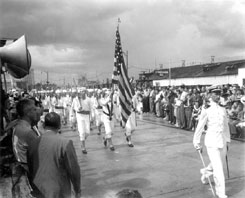Daguerreotype to Digital
A Brief History of the Photographic Process
Cellulose Acetate: "safety film"
Period of Use: 1934 - present

Movies, amateur roll films, color negatives and slides are still being produced on cellulose acetate film which was introduced in 1925 by Eastman Kodak to replace nitrate.*
Like nitrate, this unstable film base created several preservation and safety issues. As acetate film deteriorates, acetic acid is released inside the plastic support and gradually diffuses to the surface, causing a sharp vinegar-like odor. Over a period of time the film base shrinks and the emulsion buckles. This deterioration is greatly accelerated by poor storage conditions.
*Safety film was actually used as early as 1912 in the Edison Home Kinetoscope -- a hand-cranked, arc-lamp motion picture projector designed and built in Thomas Alva Edison's laboratories. The film for this projector was 22mm wide, on produced on Eastman safety stock.


 Listen: The World Program
Listen: The World Program

